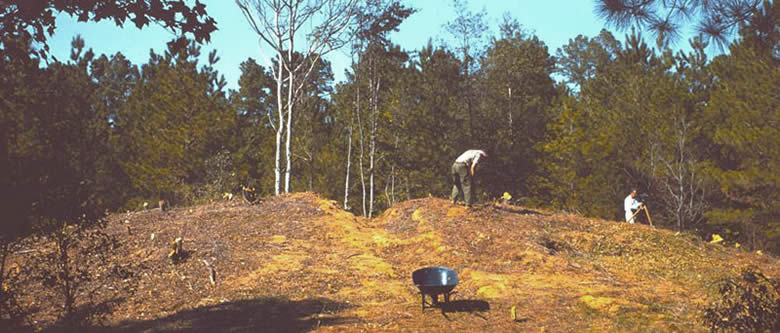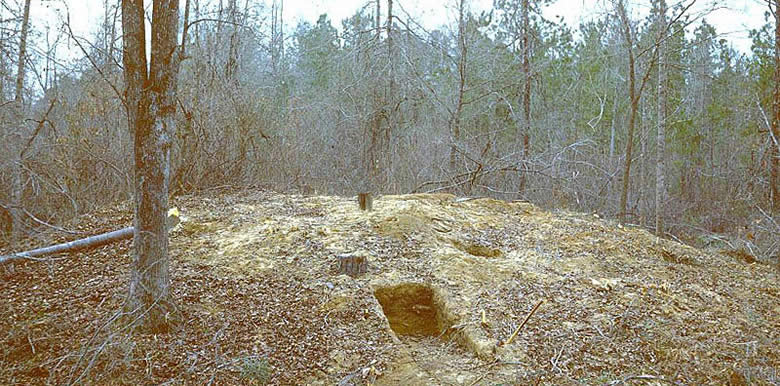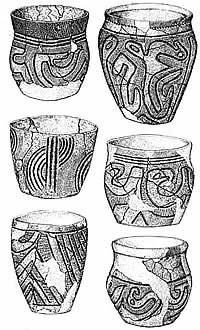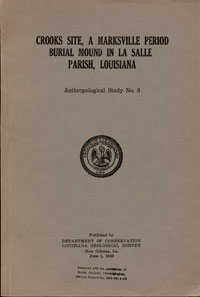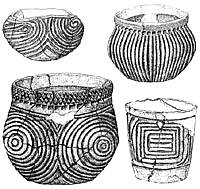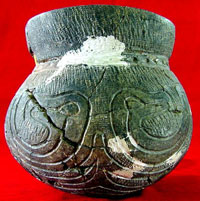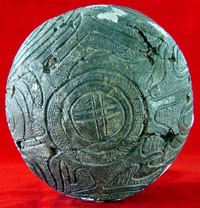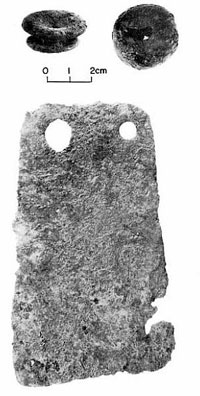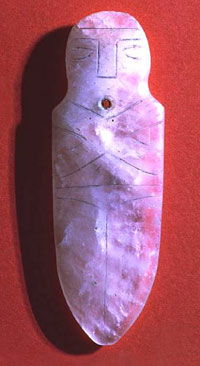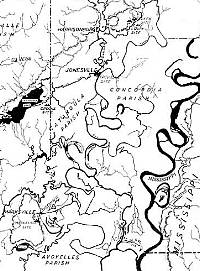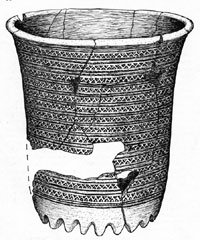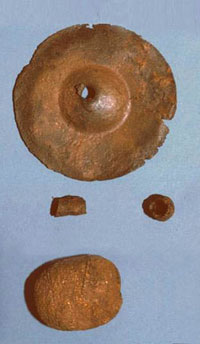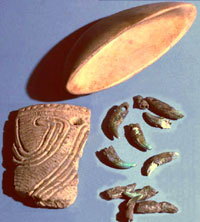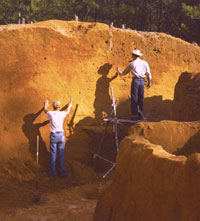
Jonas Short Mound under excavation.
The man on the right is standing at about the original
ground surface. Most of the mound seems to have been
built in a single construction episode. TARL archives.
|
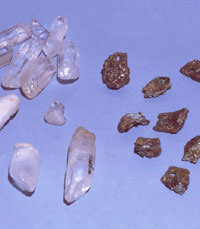
Perforated elk teeth (preserved by
proximity to copper artifacts) and quartz crystals from
Jonas Short. Five of the crystals were shaped and perforated
or grooved to serve as pendants. TARL archives.
|
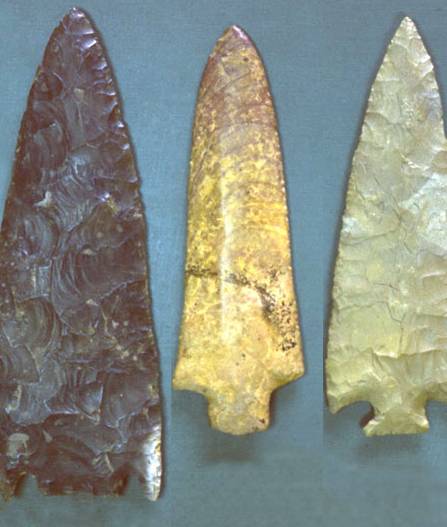
These large dart points and knives
from the Jonas Short Mound were obviously made by a
master knapper and used as ritual items. The flake scars
(chipping marks) on the extraordinary yellow point have
been completely obliterated by polishing, underscoring
its symbolic value. TARL archives.
|

Large dart points knives as they
were found within the Jonas Short Mound. TARL archives.
|

The approximate limits of the Woodland
culture areas defined within the main Caddo Homeland
and some of the better known Woodland sites dating between
about 500 B.C. and A.D. 800. Graphic by Dee Ann Story.
|
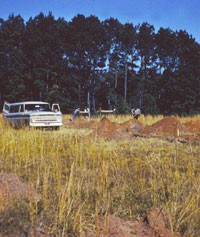
Test excavations underway in 1963
at the Late Woodland Pace site on the Louisiana side
of Sabine River just above Toledo Bend Reservoir. TARL
archives.
|
The hallmark of Fourche Maline culture is a well-developed
ceramic tradition known for its plain and minimally
decorated flat-bottomed vessels shaped like flower pots.
|
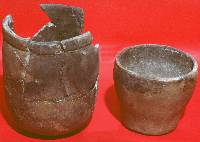
Late Woodland pottery vessels from
the Fanny Snipes site on the Sulphur River near Texarkana.
The jar on the left resembles French-Fork Incised, a
Coles Creek type, but was probably made locally. On
the right is a typical "flowerpot" Williams
Plain flat-bottomed jar, one of the hallmarks of Fourche
Maline culture. TARL archives.
|
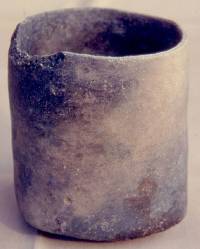
Typical Fourche Maline Williams Plain
jar from the Crenshaw site, Miller County, Arkansas.
Photo by Frank Schambach.
|
| The hallmark of Mossy
Grove culture, its sandy paste ceramic tradition, was
probably introduced or inspired by the Tchefuncte culture
in the lower Mississippi Valley. |
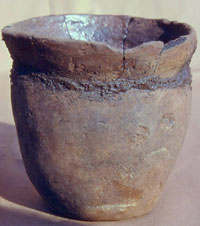
Flared-rim Williams Plain jar from
Fourche Maline contexts at the Crenshaw site, Miller
County, Arkansas. Photo by Frank Schambach.
|
The Mill Creek culture encompasses the period from
about 200 B.C. to A.D. 800 and is contemporaneous with
Fourche Maline and Mossy Grove, but different from either.
|

Double-bitted stone axes are often
found in Fourche Maline sites. These examples are from
Red River County, Texas. TARL archives.
|
|
Only a few of the burials at Coral Snake Mound
were definitely accompanied by grave goods, but small numbers
of exotic artifacts were placed into the mound as caches or
discrete clusters. Some artifact caches and other isolated
artifacts may actually represent burials in which the bones
did not survive. Regardless, these artifacts clearly represent
purposeful deposits of offerings honoring the dead. Among
the unusual artifacts are rolled copper beads, copper gorgets,
perforated raccoon teeth, two Marksville pottery vessels, two boatstones
(ground and polished artifacts shaped like a boat), and a
unique quartz figurine. The captions of the accompanying photographs
provide further details.
Three radiocarbon dates and the associated Marksville
pottery vessels indicate that Coral Snake Mound was in use during Middle
Woodland times in the early centuries A.D. Some effort was
made to locate contemporary habitation areas that might have
been associated with the mound/cemetery, but none were found.
Scattered artifacts found in and near the mound such as pottery
sherds, flint flakes, and broken dart points, probably represent
occupational debris, but the mound site itself appears to
be mainly a cemetery. The precise cultural affiliation of
Coral Snake is debated. While it could represent an as-yet
poorly known local Woodland group, Arkansas archeologist Frank
Schambach argues that Coral Snake Mound is part of Fourche
Maline culture.
Another somewhat similar site is the Jonas
Short Mound located on the Angelina River under what is
today Sam Rayburn Reservoir, some 40 miles (70 kilometers)
west of Coral Snake. The Jonas Short Mound was 29 meters (94
feet) in diameter and 2.4 meters high (almost 8 feet) and
was built over the cremated remains of at least two individuals
placed into a shallow pit. Charcoal and scorched earth suggest
that the cremation took place within the pit, followed soon
by the building of the mound, probably in two stages. The
cremated remains were accompanied by two copper bracelets.
Five artifact caches were found in the mound fill that may
have accompanied burials (if so, the bones decayed completely)
or may be offerings honoring the cremated individuals. Among
the unusual artifacts in these caches are boatstones, perforated
elk teeth, a copper reel-shaped gorget, large chipped stone
knives (bifaces), an extraordinary polished dart point, and
11 quartz crystals, five of which were shaped and perforated
or grooved to serve as pendants.
The date of Jonas Short Mound is uncertain,
but it probably also dates to the Middle Woodland period as well
and may be a bit earlier than Coral Snake judging by the reel-shaped
copper gorget. Similar artifacts are known from early Marksville
burial mounds and in burial mounds of the Adena culture of
the Ohio River valley far to the northeast. The presence of
plain sandy paste pottery and the absence of Marksville
pottery or bone- or grog-tempered pottery suggests that Jonas
Short was created by a different culture than that of Coral
Snake (or possibly by the same culture in earlier days). It
falls within the area where the Mossy Grove culture existed,
as discussed in Part 2. Schambach thinks Jonas Short is also
part of the Fourche Maline tradition.
Other Middle Woodland sites with burial mounds
occur in the vicinity of the Great Bend of the Red River in
northwest Louisiana and southwest Arkansas. In fact, there
are probably as many Middle Woodland mound sites in the eastern
part of the Caddo Homeland as there are in the LMV, although
few are well known. The Bellevue Mound and related sites in
northwest Louisiana were thought by earlier researchers to
represent a phase of the Marksville culture. Such LMV-centric
views are no longer widely held today, as archeologists in
the region see much evidence of local developments that parallel
those of the lower Mississippi Valley. Arkansas archeologist
Frank Schambach sees these sites as early expressions of Fourche
Maline culture (see Part 2).
In Arkansas, Shane's Mound and Red Hill Mound
are examples of burial mounds with similar grave offerings
to those found at Coral Snake including a Marksville stamped
bowl containing copper beads (Red Hill). Both mounds are associated
with nearby habitation areas (middens) and both are attributed
to Fourche Maline. Interestingly, both the Bellevue Mound
and the Cicero Young Mound (in Arkansas) were built over the
remains of structures, a practice which is common at Caddo
sites. These may be early examples of mounds that mark civic
and ritual centers. This is hard to demonstrate because what
little work has been done at most of these sites has focused
only on the mounds themselves.
The succeeding Late Woodland era in the
lower Mississippi valley is divided into two periods, Baytown
(about A.D. 500 to 750) and Coles Creek (about A.D.
750 to 1000), and is a time of great change. Compared to Marksville,
there are more sites, much more ceramic variability, more
densely concentrated populations, and fewer graves with exotic
offerings. Three new developments during the Late Woodland
in the LMV are particularly important: the gradual adoption
and increasing importance of agriculture, the replacement
of the atlatl and dart with the bow and arrow around A.D.
700, and the construction of planned villages and civic/ritual
centers ("mound centers") with flat-topped structural
"platform" mounds arranged around an open plaza.
These complex and interlinked changes coincide with (and are
no doubt related to) comparable developments in many parts
of the Midwest and Southeast including the Caddo Homeland.
We would argue that by about A.D. 800, developments
in the LMV no longer overshadow and anticipate those in the
Caddo area. Said differently, Caddo culture emerges as a distinct
pattern during the Late Woodland period.
Part 2: Woodland Cultures in and near the
Caddo Homeland
The above map shows the approximate location
of some of the major archeological cultures dating to the
Woodland period between about 500 B.C. and A.D. 700. As we
have seen, there was a succession of Woodland cultures within
the LMV spanning this 1200-year era. Unfortunately, the chronology
of Woodland developments in the Caddo area is poorly known
except by general comparison to the LMV sequence. Somewhat
clearer is the geographical distribution of some of the major
Woodland cultural patterns in and near the Caddo Homeland
as shown in the accompanying map. Before discussing the three
Woodland cultures whose boundaries partially overlap with
the area that would soon become the main Caddo Homeland, brief
mention will be made of three related patterns, two comparatively
well known and the other newly proposed and a matter of debate.
The influence of Middle to Late Woodland
cultures of the LMV seems to have extended well up the Red
River into the southeastern part of what would become the
Caddo Homeland. Based on data from excavations at the Fredericks,
Black Lake Bayou, and Lemoine sites (among others) in the
vicinity of Natchitoches, Louisiana, archeologist Pete Gregory
has defined the Fredericks phase (about A.D. 400-700) and
succeeding Lemoine phase (A.D. 700-900). Sites of both phases
are dominated by what appear to be locally made LMV pottery
types. By A.D. 1000, Early Caddo sites dominate the area,
but it is not clear whether this represents the movement of
people or the spread of the Caddo cultural tradition into
the Natchitoches area.
The Late Woodland Plum Bayou culture existed
in the alluvial lowlands along the lower Arkansas and White
rivers and the adjacent Mississippi Valley in eastern Arkansas
between A.D. 700-1000. The best-known Plum Bayou site is Toltec
Mounds, a major civic/ritual mound center containing 18 earthen
mounds enclosed by a C-shaped pattern of earthen berms and
ditches. Ten of the mounds at Toltec are arranged around a
rectangular plaza centered on the largest mound, which is
about 15 meters (50 feet) high. Plum Bayou culture developed
out of Baytown and is considered by many to be the northern
part of the LMV Late Woodland pattern. Interaction with Fourche
Maline and early Caddo peoples to the west and southwest is
indicated by similarities in pottery and by imported lithic
(stone) materials from the Ouachita Mountains in southwest
Arkansas.
Schambach proposed the name "Mulberry
River" to characterize the Woodland culture that inhabited
the valleys of the middle Arkansas River and its tributaries
to the north of the Ouachita Mountains in eastern Oklahoma
and northwestern Arkansas. Mulberry River culture is said
to be ancestral to the Arkansas Basin ("Northern Caddoan")
culture that developed in the same area after A.D. 900 and
created the spectacular Spiro site. While some Oklahoma archeologists
apparently consider the area part of the Fourche Maline Woodland
culture, Schambach sees Mulberry River as being distinct from
Fourche Maline. He points to differences in artifacts, settlement
patterns, and adaptation that set the two cultures apart.
The most compelling line of evidence comes from a study of
dental patterns that suggests the peoples living in the Arkansas
Valley were genetically distinct from those living in the
main Caddo Homeland from Woodland times forward.
Be this as it may, Oklahoma archeologist Don
Wyckoff sees no archeological basis for considering local
Woodland sites to be anything other than Fourche Maline. As
discussed below, the name and the original definition of Fourche
Maline culture is based on work done along tributaries
of the Arkansas River in eastern Oklahoma. Published statements
by various Oklahoma archeologists including Jerry Galm, Robert
Bell, and Wyckoff state that Fourche Maline sites are only
found in the valleys of the northern Ouachita Mountains, while
the Arkansas Valley, proper, was unoccupied until after A.D.
700.
Suffice it to say that the Mulberry River culture
concept is still in its infancy and may not survive. Proposed
archeological concepts are often like that—some stick
and some sink. Happily, here we are far more concerned with
the Woodland cultures of the main Caddo Homeland south of
the Arkansas River Valley.
Fourche Maline Culture
The most distinctive Woodland cultural pattern
in the main Caddo Homeland is the long-lived Fourche Maline
(pronounced foosh-ma-lean) culture tradition. It is named
after a creek in the Wister Valley of southeastern Oklahoma
where the "type" sites (those first used to define
the pattern) were excavated by WPA teams in the late 1930s.
These sites had distinctive thick, dark middens called "black
mounds" that contained a mix of Archaic, Woodland, and
Northern Caddoan artifacts as well as burials.
Beginning in the 1970s, the Fourche Maline concept
has been expanded and redefined by Frank Schambach to characterize
the Woodland cultures in southeastern Oklahoma, southwestern
Arkansas and adjacent areas of Louisiana and Texas. Beginning
dates are uncertain, but the earliest Fourche Maline sites
probably date to Early Woodland times, before 500 B.C., while
the latest date to A.D. 800 (or later), a span of at least
13 centuries. Schambach has divided the Fourche Maline time
span into seven numbered periods that correspond to the LMV
sequence. He has also defined six Fourche Maline phases covering
different subareas and spans of time. Because the dating for
these phases (and the periods, too) is based mainly on cross-dating
with LMV ceramics, other archeologists, such as Story and
Perttula, regard them as highly conjectural.
Outside the Wister Valley, the best archeological
evidence of Fourche Maline culture comes from the Red River
and Ouachita River drainages in southwestern Arkansas where
some 700 related sites have been recorded. Southwestern Arkansas
and adjacent areas of Oklahoma, Louisiana, and Texas appear
to have been the core area of Fourche Maline culture where
some of the oldest, largest, and most intensively occupied
sites are found. Fourche Maline sites are known for their
thick, black middens resulting from habitation and trash accumulation
over lengthy periods of time. It is assumed that villages
once stood in these places, although little direct evidence
of dwellings have been found, probably because Fourche Maline
houses were not very substantial. While most sites are relatively
small, larger villages covering 2 hectares (about 5 acres)
also occur.
The hallmark of Fourche Maline culture is a
well-developed ceramic tradition known for its plain and minimally
decorated flat-bottomed vessels. The most common form is a
jar shaped like a flower pot. Fourche Maline ceramics typically
have thick walls and are tempered with a variety of materials
including grog, bone, grit, and sand. The most common type
is Williams Plain followed by Cooper Boneware and Ouachita
Plain. Excavations of Fourche Maline middens often yield thousands
of pottery sherds. Trade pieces of Marksville and Coles Creek
pottery are known, but more common are locally made imitations
of LMV pottery. Other characteristic artifact types include
Gary dart points and, after about A.D. 500, expanding stem
arrow points, as well as boatstones, double-bitted "axes"
(possibly gardening hoes), clay platform pipes, and seed grinding
and nutting stones.
The economy of Fourche Maline peoples is still
something of a mystery. They obviously continued the Archaic
hunting and gathering tradition and lived in part off of deer,
turkey, and hickory nuts as well as many other wild plants
and animals. The mysterious part is the extent to which they
were gardeners. It seems likely that, through time, Fourche
Maline peoples began growing various native crops including
the starchy and oily plants that were domesticated first in
the American Midwest as well as squash and bottle gourds.
While little direct evidence of gardening so far has been
recovered from Fourche Maline sites, this is probably due
mainly to the recovery techniques used by archaeologists. (Small charred seeds are
only preserved in favorable conditions and can only be recovered
by using a specialized soil processing method called flotation.)
Indirect evidence of horticulture includes the presence of
double-bitted "axes" (possible garden-hoe blades),
the dense refuse accumulations (black middens) at many Fourche
Maline sites, and the increasing evidence that neighboring
Woodland groups living east, north, and west of the area were
part-time gardeners.
Fourche Maline burial practices are generally
similar to Woodland patterns in the Midwest (Adena-Hopewell).
In the Red River valley of southwestern Arkansas, the earliest
burial mounds (ca. 200-100 B.C.) were built on bluff tops
away from habitation areas. These small domed mounds were
built over crematoria (places where cremations took place),
a common Early and Middle Woodland pattern in the Eastern
Woodlands. Some cremated remains and grave offerings are found
within the mounds, but cremation cemeteries such as the Johnny
Ford site suggest that bodies were burned in one place and
interred in another. Somewhat later mounds such as Shane's
mound covered central pits containing cremated remains but
also have small offering deposits (caches) of exotic Hopewell-related
artifacts similar to those found at Jonas Short Mound, 150
miles to the southwest. (While Schambach considers Jonas Short
to be a Fourche Maline site, Story considers the pottery found
there to be that of Mossy Grove culture.)
Between A.D. 100-300, burial mounds such as
those at Red Hill and McKinney in the Red River valley were
no longer built over crematoria. Instead they have secondary
deposits of cremations (McKinney) that are associated with
exotic Hopewell-related artifacts, and Marksville Stamped
bowls. Although neither of these mounds is well known, Schambach
believes they are similar to Coral Snake Mound, which he also
considers to be a Fourche Maline site. The latest Fourche
Maline burial mounds are Mounds C and D at the Crenshaw site
and are thought to date to A.D. 600-700. These mounds were
built in stages and have deposits of skulls and mandibles
with pottery vessels and other offerings that were placed
on the surfaces of the mound stages and then covered by thin
clay caps.
Schambach argues that Fourche Maline culture
represents the mother culture from which the Caddo cultural
tradition develops and sees Fourche Maline peoples as the
direct ancestors of later Caddo peoples. There is much evidence
to support this view. The most obvious is the fact that the
core area of Fourche Maline closely coincides with the core
area of the Caddo Homeland coupled with the absence of a gap
in time between the two cultural traditions. There are seemingly
abrupt changes in behavior including new burial patterns,
ceramic styles, increased mound building, increasing use of
mounds as building platforms, ritual destruction and capping
of public buildings, and the introduction of maize agriculture.
Nonetheless, these appear to represent local social and economic
developments rather than the movement of a new people into
the area. While these changes may seem abrupt, the cultural
transformation from Fourche Maline to Early Caddo probably
transpired over several hundred years (ca. A.D. 700-900) and
it may well be more complicated than implied by the mother
culture idea. There are two other Woodland cultures in east Texas that probably
contributed to the development of the Caddo cultural tradition,
Mossy Grove and Mill Creek.
Mossy Grove Culture
The Woodland period archeological pattern in
southeast Texas along the upper Gulf coast and inland into
the southern part of the Piney Woods looks quite different
from Fourche Maline. Many of the differences obviously relate
to the contrasting environments. Southeast Texas has greater
rainfall, higher humidity, a longer growing season, more swamps,
less oak-hickory forest, and, of course, the estuaries, bays,
and barrier islands along the Gulf Coast. These environmental
differences resulted in dissimilar economic patterns, access
to raw materials (scarcity of stone, for instance), shelter
needs, and so on. The area is also less conducive to farming.
Farther inland toward what would become the southern boundary
of the Caddo Homeland, away from the relatively narrow river
valleys, there are deep sandy soils that are not very fertile
and dry out quickly during droughts.
From early historic records we know that much
of Southeast Texas, particularly along the coast and major
bay systems (and adjacent inland areas), was occupied by non-Caddoan
speakers such as the Bidai, Atakapa, and Akokisas peoples.
The archeological record suggests that the historically known
patterns began developing thousands of years ago, certainly
by Woodland times.
In the early 1990s, Dee Ann Story called attention
to the archeological similarities across much of Southeast
Texas, especially the shared sandy paste pottery tradition,
and termed this pattern the Mossy Grove cultural tradition.
While the Mossy Grove tradition can be traced into historic
times, our interest here is on the Woodland or "Early
Ceramic" period, beginning by at least 200 B.C. and probably
earlier. Unfortunately for our present purpose, the archeological
sequence of the coastal Mossy Grove culture is much better
known than that present within the southern part of the area
we recognize as the Caddo homeland.
The hallmark of Mossy Grove culture, its sandy
paste ceramic tradition, was probably introduced or inspired
by the Tchefuncte culture in the LMV as is evident from finds
of Tchefuncte-like pottery at both coastal and Inland Mossy
Grove sites. In contrast to the thick-walled, flat-bottomed
plainwares of Fourche Maline, Mossy Grove peoples created
relatively thin-walled, round- or conical-bottomed vessels.
The double-bitted axes and polished stone artifacts found
in Fourche Maline sites are absent. Mossy Grove projectile
points include small Gary and Kent dart points and, after
about A.D. 500-600, expanding stem arrow points of the Friley and
Scallorn types. These artifacts and various knives (bifaces)
and heavier chopping tools are made of poor quality local
materials, often petrified wood. Another local raw material
for making chipped stone tools is Manning glass, a fused volcanic
material that outcrops in a narrow east-west band near the
southern limit of the Caddo Homeland just north of Huntsville,
Texas.
In the northern Mossy Grove area, along the
upper Angelina and Neches River valleys, Woodland sites are
very common and account for 25-50 percentage of the known sites. The
increase in sites compared to the Archaic period is also coupled
with a shift in settlement location from upland areas and
higher ridge tops to the low sandy ridges ("interfluves")
overlooking the confluences of small drainages. Archeologist
Jim Corbin has speculated that this shift may be tied to the
beginnings of gardening, although so far there is no direct
evidence of early domesticated plants. The sandy, acidic sediments
of the area make for poor preservation of organic materials.
Mill Creek Culture
In East Texas to the west and south of the Red
River and its tributary, the Sulphur River, Woodland archeological
sites seem to differ significantly from the Fourche Maline
pattern. For one thing there are far fewer Woodland sites
and those that are present are smaller and do not seem to have
the characteristically thick, black middens with abundant
Williams Plain pottery. The relatively small amounts of pottery
that the East Texas sites have is more varied; it is typically
thinner than Williams Plain and more often decorated with
incised lines, punctations, and other designs. Archeologist
Tim Perttula has argued that these and other differences
suggest that a distinct cultural pattern existed in the western
frontier of the Eastern Woodlands in the Pineywoods of East
Texas and the Post Oak Savanna.
The Mill Creek culture encompasses the period
from about 200 B.C. to A.D. 800 and is contemporaneous with
Fourche Maline and Mossy Grove, but different from either.
Sites of this culture are known mainly in the Big Cypress Creek
and Sabine River basins in East Texas, but apparently continue
eastward into northwest Louisiana. Because relatively few
Mill Creek sites have been recognized and investigated by
archeologists, the concept must be regarded as quite tentative.
(Like Mulberry River culture, Mill Creek culture is an idea that may or may not become widely accepted.)
Perttula hypothesizes that Mill Creek groups
moved around more (i.e., were less sedentary) than Fourche
Maline groups, based on the presence of only relatively small sites
and small middens. The fact that ceramics are not abundant
at Mill Creek sites compared to Fourche Maline or Mossy Grove
sites, may represents regional differences in food processing.
Mill Creek peoples appear to have relied on traditional cooking
and storage techniques such as pit-oven cooking and storage
pits rather than on ceramic technology. Mill Creek peoples
still practiced the hunting and gathering lifestyle of their
Archaic predecessors and relied heavily on nuts and deer.
No structures, burials, or burial mounds have yet been identified
at Mill Creek sites. Stone tools include small Gary and Kent
dart points eventually being replaced by expanding-stem arrow
points about A.D. 600-700. Ground stone tools, particularly
manos and pitted nutting stones are common. Double-bitted
"axes" are uncommon as are other potential gardening
tools. Most stone tools are made of local quartzite, sandstone,
siltstone and petrified wood.
The best known Mill Creek site is the Herman
Bellew site, which overlooks Mill Creek, a tributary of the
Sabine River in northern Rusk County. The Woodland ceramics
from the site include sandy paste, grog-tempered, and bone-tempered
sherds, a relatively high percentage of which are decorated
(6 percentage compared to less than 3 percentage for most Fourche Maline sites).
Despite relatively extensive excavation, only 225 sherds were
recovered at Herman Bellew. In comparison, many Fourche Maline
sites have yielded thousands of sherds.
According to Perttula and archeologist Linda W. Ellis, Mill Creek pottery differs from the
typically thick, grog-tempered Williams Plain. Instead, there
is a mix of sandy paste wares, bone-tempered wares, and thinner
grog-tempered wares, primarily plain. Mill
Creek groups may have adopted ceramic ideas and technologies
from the two neighboring Woodland cultures with whom they
were interacting. From the Fourche Maline tradition came grog-
and bone-tempered pottery with mainly flat-based bowls and
jars combined with the Mossy Grove tradition of non-tempered
sandy paste wares with round-based vessels. Alternatively,
the apparent borrowing from adjacent cultures may simply be
changes through time in manufacturing technique and vessel
shape that represents the evolution of ceramic use for different
purposes by Mill Creek peoples.
Another important difference between Fourche
Maline and Mill Creek is the presence in the latter of rock
hearths and storage pits. Small rock hearths (probable earth
ovens) and larger concentrations of fire-cracked cooking stones
were found in Woodland contexts at Herman Bellew, suggesting
that the Archaic pattern of using hot rocks to cook plant
foods (especially roots) was still prevalent. Another example
of a continued Archaic pattern is a large storage pit dating
to about A.D. 100-200.
Woodland Summary:
What can we say about the cultures that came
just before the Caddo? While a great deal remains to be learned
before we can trace the early ancestors of the Caddo people,
some of the larger patterns seem clear. Woodland peoples were
living throughout Caddo Homeland for over a thousand years
before A.D.800-900, the period when the Caddo cultural tradition
is first recognized by archeologists. During the 1300 years
between 500 B.C. and A.D. 800, Woodland peoples in the region:
- • expanded their numbers and populated the
area more densely
- • became increasingly sedentary and established
semi-permanent settlements, including villages
- • adopted ceramic technology for cooking and
storage
- • began a distinctive ceramic tradition with
elaborate forms and incised designs
- • began to cultivate squash/gourds and starchy
and oily seed plants
- • adopted the bow and arrow and stopped using
the atlatl and dart as the principal weapon
- • acquired exotic items from distant sources
(Hopewell/Marksville network)
- • treated their dead in increasingly elaborate
ways
- • established burial mounds and the first platform
mounds at ritual centers
- • developed hereditary political and religious
leadership
These developments and changes were not simultaneous,
and they did not take place all across the region. We still
do not understand either the exact sequences of development,
or the processes of change. In a sense most of these Woodland
elements were different parts of the same general process:
the transformation from small egalitarian groups of mobile
hunters and gatherers to larger, ranked societies who depended
on agriculture.
The Fourche Maline culture of the Red River
valley was almost certainly the main "mother" culture
out of which the Caddo cultural tradition evolved. But that
does not mean that all of the ancestral Caddo groups were part
of the Fourche Maline tradition. Ancestral Caddo peoples may
have been responsible for the Mill Creek culture to the south
and west of the Fourche Maline. Mossy Grove culture, on the
other hand, probably represents the ancestors of non-Caddo
peoples, but they were clearly interacting with Mill Creek
and Fourche Maline peoples. Said differently, Woodland groups
across the Caddo Homeland developed localized ways of doing
things that had their origins long before A.D. 800. The smaller
groups that lived on the western and southern fringes were
probably perceived as being akin to "country hicks"
(or perhaps even enemies) by the larger, more mainstream groups
that lived in the Caddo "heartland"—the Red
River Valley at and below the Great Bend.
|

Reel-shaped copper gorget and copper
bracelets from Jonas Short. Similar reel-shaped artifacts
are known from early Marksville burial mounds and in
burial mounds of the Adena culture of the Ohio River
valley far to the northeast. TARL archives.
|
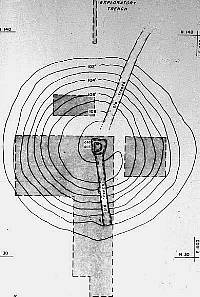
Map showing area excavated at the
Jonas Short Mound. TARL archives.
|
|
|
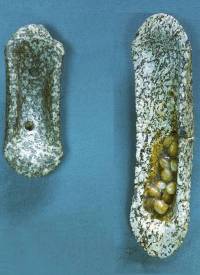
These boatstones from Jonas Short
Mound are made from syenite and probably come from outcrops
near Little Rock, Arkansas. The smooth river pebbles
in the one on the right are still in the original find
position within the boatstone. These probably served
as rattles held within because the boatstone was tightly
affixed to its atlatl. This lends additional support
to the notion that atlatls with exotic boatstones were
strictly ritual objects—what hunter would want
his presence announced by a loud rattle? TARL archives.
|
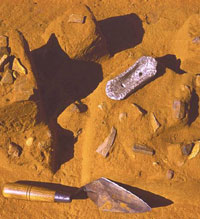
Apparent artifact caches found within
Jonas Short Mound may have once been associated with
cremated burials. If so, the evidence was not preserved.
The syenite boatstone is obviously a ritual artifact,
but the smaller bits look like ordinary debris. TARL
archives.
|

Coles Creek-like pottery from the
Pace site on the Louisiana side of Sabine River just
above Toledo Bend Reservoir. TARL archives.
|
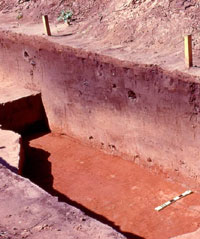
Buried Fourche Maline midden exposed
in excavation wall at the Crenshaw site. Although the
dark stain of this midden is clearly visible, some Fourche
Maline middens are so dark they are described as being
black. Courtesy Frank Schambach.
|
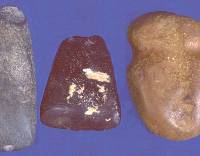
Polished stone celts and grooved
axe from Fanny Snipes site. The celts probably date
to Late Woodland or Early Caddo times, while the grooved
axe is probably a much older Archaic artifact. The Snipes
site, like many sites in the Caddo Homeland, has a mixture
of artifacts dating to different periods. TARL archives.
|
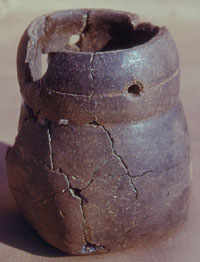
French Fork Incised jar from a Fourche
Maline context at the Crenshaw site, Miller County,
Arkansas. Although this is a Coles Creek style commonly
found in the lower Mississippi Valley, it was probably
made locally by Fourche Maline potters. Photo by Frank
Schambach.
|

Unique four-chambered Fourche Maline
pottery vessel from the Crenshaw site, Miller County,
Arkansas. Dozens of unique pots have been found at this
site that are unlike any known elsewhere. The inventiveness
of the Crenshaw Fourche Maline potters anticipates that
of early Caddo potters. Photo by Frank Schambach.
|
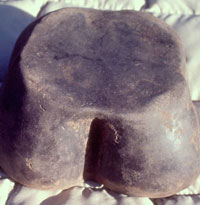
Bottom view of unique four-chambered
Fourche Maline pottery vessel from the Crenshaw site,
Miller County, Arkansas. Photo by Frank Schambach.
|
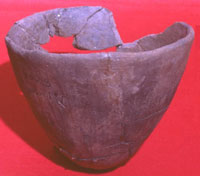
Cone-shaped sandy paste vessel from
a Mossy Grove site in Polk County, Texas. Whole Mossy
Grove pots are rare. TARL archives.
|
| |
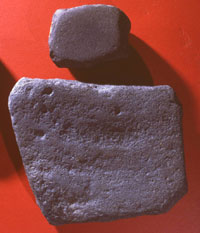
Nutting stones and grinding slabs
such as these are found in Woodland as well as Late
Archaic sites in the Caddo Homeland. TARL archives.
|
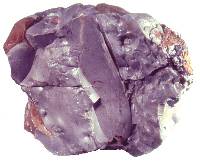
Manning Fused Glass, a volcanic material that outcrops
in a narrow east-west band near the southern limit of
the Caddo Homeland just north of Huntsville, Texas. This
material was used by local Caddo peoples to make stone
tools. It is, however, characteristically fractured, as
this piece is. It is also usually found in small nodules.
This example is the largest known nodule of Manning Fused
Glass, measuring about a meter across (39"). Photo
by Ken Brown. |
|
